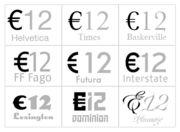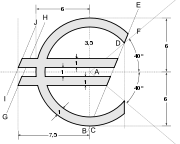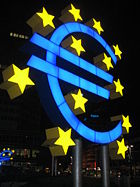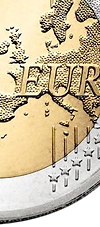Euro sign

The euro sign (€) is the currency sign used for the euro, the official currency of the European Union (EU). The design was presented to the public by the European Commission on 12 December 1996. The international three-letter code (according to ISO standard ISO 4217) for the euro is EUR.
Contents |
Design

The euro currency sign (€) was designed to be similar in appearance to the old sign for the European currency unit, ₠. After a public survey had narrowed the original ten proposals down to two, it was up to the European Commission to choose the final design. The eventual winner was a design created by a team of four experts whose identities have not been revealed.
| “ | Inspiration for the € symbol itself came from the Greek epsilon (Є) – a reference to the cradle of European civilisation – and the first letter of the word Europe, crossed by two parallel lines to ‘certify’ the stability of the euro. | ” |
The official story of the design history of the euro sign is disputed by Arthur Eisenmenger, a former chief graphic designer for the European Economic Community, who claims he had the idea prior to the European Commission.[2]
The European Commission specified a euro logo with exact proportions and colours (PMS Yellow foreground, PMS Reflex Blue background [3]), for use in public-relations material related to the euro introduction. While the Commission intended the logo to be a prescribed glyph shape, font designers made it clear that they intended to design their own variants instead.[4]
Use on computers

Generating the euro sign using a computer depends on the operating system and national conventions. Some mobile phone companies issued an interim software update for their special SMS character set, replacing the less-frequent Japanese yen sign with the euro sign. Later mobile phones have both currency signs.
The euro is represented in the Unicode character set with the character name EURO SIGN and the code position U+20AC (decimal 8364) as well as in updated versions of the traditional Latin character set encodings.[5] In HTML, the € entity can also be used. The HTML entity was only introduced with HTML 4.0, shortly after the introduction of the euro, and many browsers were unable to render it. The alternative was to use € instead, with 128 (80 hexadecimal) being the code position of the euro sign in most Windows 125x encodings.
An implicit character encoding, along with the fact that the code position of the euro sign is different in common encoding schemes, led to many problems displaying the euro sign in computer applications. While displaying the euro sign is no problem as long as only one system is used (provided an up-to-date font with the proper glyph is available), mixed setups often produced errors. One example is a Content management system where articles are stored in a database using a different character set than the editor's computer. Another is legacy software which could only handle older encodings such as ISO 8859-1 that contained no euro sign at all. In such situations, character set conversions had to be made, often introducing conversion errors such as a question mark (?) being displayed instead of a euro sign.
Care has been made to avoid replacing an existing obsolete currency sign with the euro sign. That could create different currency signs for sender and receiver in e-mails or web sites, with confusions about business agreements as a result.
The Compose key sequence for the euro sign is =C.
Usage

Placement of the sign also varies. Partly since there are no official standards on placement,[6] countries have generated varying conventions or sustained those of their former currencies. For example, in Ireland and the Netherlands where former currency signs (£ and ƒ, respectively) were placed before the figure, the euro sign is universally placed in the same position[7]. In many other countries, including France, Germany and Spain, an amount such as €3.50 is often written as 3,50 € or 3€50 instead, largely following conventions for their former currencies.
In English language use, like the dollar sign ($) and the pound sign (£), the euro sign is generally placed before the figure,[8] as used by publications such as the Financial Times and The Economist[9].
No official recommendation is made with regard to the use of a cent sign, and usage differs between and within member states. Sums are often expressed as decimals of the euro (for example €0.05 or €–.05 rather than 5c). The most common abbreviation is "c", but the cent sign "¢" also appears. Other abbreviations include "ct" (particularly in Germany and Spain), "snt" (Finland) and Λ (the capital letter lambda for λεπτό, "lepto", in Greece).
Further reading
- Commission of the European communities Communication from the Commission: The use of the €uro symbol(PDF) 23 July 1997 [COM(97) 418 final]
References
- ↑ European Commission - Economic and Financial Affairs - How to use the euro name and symbol
- ↑ Observer | Inventor who coined euro sign fights for recognition
- ↑ European Commission - Economic and Financial Affairs - How to use the euro name and symbol
- ↑ Typographers discuss the euro, from December 1996.
- ↑ For details please see the Western Latin character sets (computing).
- ↑ Frequently Asked Questions
- ↑ Euro: valutateken voor of achter het bedrag?, Nederlandse Taalunie, retrieved 21 December 2006.
- ↑ Article on linguistics: Currency units, TranslationDirectory.com, retrieved 25 June 2008.
- ↑ Economist.com Research Tools: Style Guide, TranslationDirectory.com, retrieved 15 July 2008.
|
||||||||||
|
|||||
|
||||||||||||||||||||||||||||||||||||||||||||||||||

